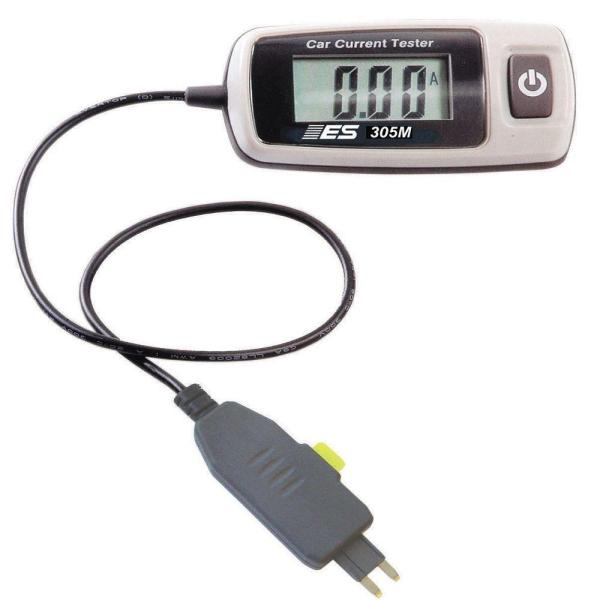Sometimes things you take for granted and have in your toolbox of fault-finding tricks are a dark art to others.
I was talking someone through a bit of fault-finding on their vehicle and asked if they had measured the current in the circuit. “No” came back the answer. I asked what type of fuse and rating it was and asked the person to just put their voltmeter across the fuse and tell me the voltage across the fuse. “Ah… that’s about 3.2 amps then” I said.
“How do you know that?”
Simple really – all fuses have a resistance and if you know that you can work out the current from the voltage drop. Even simpler really – there are tables for various fuses that have it all worked out for you. I have a selection collected over the years stuffed into the lid of my tool box, along with a lot of other junk paperwork!
I created a volt drop table based on PEC (Pacific Engineering Corporation) fuses that are supplied as OEM fuses in most Japanese, Korean and European vehicles however it is pretty accurate for almost all other makes of the same type of fuse. I printed mine out, laminated them and added them to the collection in the top of my toolbox.

It’s quite easy to use. Just set your multimeter to read DC mV and read the voltage displayed. Now select the fuse type, in this case an ATO fuse – the most common used in vehicles, caravans and motorhomes and from the chart look down the left column until you see the voltage measurement that matches the one on your multimeter… lets say 0.011 volts (11mV)
The fuse is a red 10 Amp fuse so follow the 0.011 volt line across until you get to the 10 Amp fuse column and read the current figure… in this case 1.3547 or 1.3 Amps. It’s as easy as that, no need to break the circuit to put your multimeter in as an Ammeter.

Although the table is based on PEC ATO/ATC and MINI fuses (download info below) it is pretty close with most manufacturers fuses and as a general reference for fault-finding will be good enough to 0.1 amp.
If you need to know the actual current through a circuit, you need to use an ammeter and not rely on tables but for general work they are close enough.
These tables also come in handy if you are trying to find out why a battery is draining. Without turning anything on it is easy to run through a fusebox checking to see if any circuits have a current drain on them without having to constantly pull fuses and insert an ammeter, which sometimes can upset or reset the circuit you are working on.
One thing to remember with this test if you’re tracing a fault, is you are only measuring the volt drop across the fuse to determine current. You really need to know how much current you should be drawing. For example, If I was testing the 12 volt fridge circuit fuse and I only got a voltage drop across the fuse that calculates to 6 Amps then I’d know there was an issue somewhere along the circuit as I’d be expecting around 10 Amps or more.
A word from our Safety Officer…

Oscar would like to remind you that working on a live circuit has risks and never attempt to undertake volt drop measurements on mains circuits. Most cheap multimeters do not have the internal protection or fused test leads. Be safe. Be like Oscar.
You can down load the table in PDF format (4 pages) and either print them out or save them to your device from the following link: Fuse Voltage Drop Table
Unfortunately due to a lot of my drawings and text being used elsewhere without credit back to CaravanChronicles.com I’ve had to start putting watermarks on a lot of things. I hope this doesn’t make the table too difficult to read.
P.S. Someone told me that everything on the internet can be improved by cats and my “likes” would go through the roof!

Thanks for a very informative site. I’m not sure which country you are in. I am at a camp on the cape western coast called strandfontein. My problem is my fridge and lights and water pump which should all work on the 12v system when not plugged in to mains power are not functioning. The battery is fine as my van movers which wokr off the same battery worked fine. I have checked the fuses, all 4 and they seem fine. What else can I do myself here at camp. There isn’t an auto electrician for miles.
Hi Ian
I’m based in the UK
If three things are not working and the fuse for each of these circuits is OK and everything else works, then I’d suggest it is an neutral return problem. It sounds like the neutral for these three circuits might have a common point which should be connected to the battery neutral has become disconnected. Has anything moved in cupboards where cables run? it might be something has shifted and pulled off a terminal. Pick the easiest circuit to trace and try and follow the wires back to the fuse board and check the neutral bus bar on the fuse board.
Pingback: Vehicle Wiring Projects… Some Thoughts. | Caravan Chronicles
Pingback: A Request… | Caravan Chronicles
Pingback: Overland Vehicle Electrics and Other Stuff… | Caravan Chronicles
Pingback: For Anyone Restoring A Vintage Caravan… | Caravan Chronicles
Pingback: Euro 6 Engines, Smart Alternators and Your Leisure Battery… | Caravan Chronicles
Pingback: The problem with information from the internet… | Caravan Chronicles
Interesting read about fault finding. Great post well written. Thanks for sharing
Pingback: Something For Your Toolbox… | Caravan Chronicles
PS, another trick that works on many modern vehicles, when leaving the battery disconnected in said manner, if both battery terminals are disconnected and linked together for the half hour period, this can re-boot the vehicle and even clear fault codes without the need for a plugin job.
Very interesting reading Simon, I must admit, with all my so called knowledge, I knew that the more current drawn through a fuse the more the voltage drop across it, as in theory, the fuse blade/wire is thinner than the circuit supply cable which is why fuses start to heat up when they start getting close to their blowing value, I must admit, I did not know your shortcut trick nor what “mv” values to expect! As you say, you can check the current using your chart without pulling the fuse which on modern Cam-bus systems can cause problems to say the least. Once again, many thanks for your great tips!
Hi Colin
It’s also handy for checking return paths… say from rear light cluster to batt neg. With the lights on if you get a volt drop you have an issue with the neg return path.
I also use it to check plug in connectors for problems… check the volt drop across the connector.
Yes, good idea Simon, slightly changing the subject: On older vehicles which are Cam-bus, as the vehicle starts to get 10-15 years old the fuse blades start to oxidise which can cause mega problems within the vehicles circuitry. In this sinareio, it’s a good idea to pull each fuse in turn and wire brush the fuse blades etc. My advice to anyone undertaking this action to such older vehicle is to disconnect the vehicle battery first, I know this means resetting the radio code, electric windows and sun roof just to mention a few, but pulling fuses Willy Nilly even when the car is switched off can cause problems, in theory, modern Cam-bus vehicles are never actually switched off. By pulling fuses in this manner with the vehicle battery still connected can cause problems as many circuits are powered by multiple fuses, take for instance the ABS. On many said vehicles the ABS system is supplied through as many as 3 – 5 fuses and by pulling one fuse while the others are still in circuit can cause the ABS light to come on permanently and have to be reset by a plugin job! Im mentioning this due to several experiences.
Colin
Hi Colin
When fuses get that old, I took the view that if the blades have oxidation on them so must the ‘sacrificial’ part of the fuse possibly compromising the fuse rating. I went on to Amazon and bought a couple of boxes of mixed fuses and simply replaced the lot. The old ones being my ’emergency collection’.
I did exactly as you have said… disconnected the battery, left the vehicle for 30 min disconnected then replaced them all, re-connected and reset the radio code. Worked ok on our 12 year old (06 plate) Land Rover Freelander.
Yes, your spot on with disconnecting the battery and leaving it for half an hour for the vehicles’ system to fully de-power first, I forgot to mention that! By not allowing the vehicle to fully de-power first b4 pulling the fuses in such said manner can cause things like the Vehicles’ Air Bags to go off when replacing the fuse while the vehicle is still live, so as you have said, it’s most important!
Bearded Collies yes – cats no.
Ha Ha 😁